Exchange Currency
Indian rupee
The Indian rupees is the official currency of the Republic of India. The issuance of the currency is controlled by the Reserve Bank of India.
The modern rupee is theoretically subdivided into 100 paise (singular paisa) though this division is purely symbolic; as of 30 June 2011, 50 paise will be the minimum coin accepted in the markets as all denominations below it will cease to be legal currency. Bank notes are available in nominal values of 1, 2, 5, 10, 20, 50, 100, 500 and 1000 rupees. Coins of the rupee have nominal values of 1, 2, 5, 10, 20, 25 and 50 paise as well as 1, 2, 5 and 10 rupees. The first series of coins with the rupee symbol was launched on 8 July 2011.
On March 5, 2009 the Indian government announced a contest to create a symbol for the rupee. During the year 2010's Union Budget, Finance Minister Pranab Mukherjee mentioned that the proposed symbol would reflect and capture the Indian ethos and culture. Five symbols were shortlisted, and the Cabinet selected the definitive symbol created by son of DMK leader Udaya Kumar. The symbol is derived from the Devanagari letter ‘र’ with an additional horizontal line. The parallel lines at the top (with white space between them) make an allusion to the tricolor and also depict an equality sign which symbolizes the nation's desire to reduce economic disparity. The Indian government will try to adopt the symbol within six months in the country and globally within 18 to 24 months. Before the adoption of the symbol, the most commonly used symbols for the rupee were Rs, Re or if the text was in an Indian language, then an appropriate abbreviation in that language. The content ( ₹ <-- rupee symbol) inside the braces would only be visible if your computer have the updated version of Unicode Installed.
The selection process has been challenged under the Right to Information Act in the Delhi High Court. The petitioner, Rakesh Kumar, was a participant on the competition, described the process as "full of discrepancies" and "flawed", and named the Finance Ministry and the chairman of Indian Rupee Symbol Selection Committee as respondents. On March 31, 2011 Hon'ble Chief Justice and Hon'ble Mr. Justice Sanjiv Khanna of Delhi High Court in their judgment court allows RTI activist Mr. Rakesh Kumar Singh to file PIL against “Indian Rupee symbol selection process.
Historically, the rupee, derived from the Sanskrit word raupya, which means silver, was a silver coin. This had severe consequences in the nineteenth century, when the strongest economies in the world were on the gold standard. The discovery of vast quantities of silver in the U.S. and various European colonies resulted in a decline in the relative value of silver to gold. Suddenly the standard currency of India could not buy as much from the outside world. This event was known as "the fall of the rupee".
India was not affected by the imperial order-in-council of 1825 that attempted to introduce the British sterling coinage to the British colonies. British India at that time was controlled by the British East India Company. The silver rupee continued as the currency of India throughout the entire period of the British Raj and beyond. In 1835, British India set itself firmly upon a mono-metallic silver standard based on the rupee. His decision was influenced by a letter, written in the year 1805, by Lord Liverpool that extolled the virtues of mono-metallism.
Following the Indian Mutiny in 1857, the British government took direct control of British India. Since 1851, gold sovereigns were being produced in large numbers at the Royal Mint branch in Sydney, New South Wales. In the year 1864 in an attempt to make the British gold sovereign become the 'imperial coin', the treasuries in Bombay and Calcutta were instructed to receive gold sovereigns. These gold sovereigns however never left the vaults. As was realized in the previous decade in Canada and the next year in Hong Kong, existing habits are hard to replace. Just as the British government had finally given up any hopes of replacing the rupee in India with the pound sterling, it simultaneously realized, and for the same reasons, that they could not easily replace the silver dollar in the Straits Settlements with the Indian rupee, as had been the desire of the British East India Company.
Since the great silver crisis of 1873, a growing number of nations had been adopting the gold standard, however the Indian currency system maintained its silver-standard tradition, which remained until it was replaced by a basket of commodities and currencies in the late twentieth century.
The Indian rupee replaced the Danish Indian rupee in 1845, the French Indian rupee in 1954 and the Portuguese Indian escudo in 1961. Following independence in 1947, the Indian rupee replaced all the currencies of the previously autonomous states. Some of these states had issued rupees equal to those issued by the British (such as the Travancore rupee). Other currencies included the Hyderabad rupee and the Kutch kori.
In 1957, decimalisation occurred and the rupee was divided into 100 naye paise (Hindi for "new paise"). In 1964, the initial "naye" was dropped. Many still refer to 25, 50 and 75 paise as 4, 8 and 12 annas respectively, not unlike the usage of "bit" in American English for ⅛ dollar.
In East Africa, Arabia, and Mesopotamia the Rupee and its subsidiary coinage was current at various times. The usage of the Rupee in East Africa extended from Somalia in the north, to as far south as Natal. In Mozambique the British India rupees were overstamped, and in Kenya the British East Africa Company minted the rupee and its fractions as well as pice. The rise in the price of silver immediately after the First World War caused the rupee to rise in value to two shillings sterling. In 1920 in British East Africa, the opportunity was then taken to introduce a new florin coin, hence bringing the currency into line with sterling. Shortly after that, the Florin was split into two East African shillings. This assimilation to sterling did not however happen in British India itself. In Somalia the Italian colonial authority minted 'rupia' to exactly the same standard, and called the pice 'besa'.
The Straits Settlements were originally an outlier of the British East India Company. The Spanish dollar had already taken hold in the Straits Settlements by the time the British arrived in the nineteenth century, however, the East India Company tried to introduce the rupee in its place. These attempts were resisted by the locals, and by 1867 when the British government took over direct control of the Straits Settlements from the East India Company, attempts to introduce the rupee were finally abandoned.
With Partition, the Pakistani rupee came into existence, initially using Indian coins and Indian currency notes simply overstamped with "Pakistan". In previous times, the Indian rupee was an official currency of other countries, including Aden, Oman, Kuwait, Bahrain, Qatar, the Trucial States, Kenya, Tanganyika, Uganda, the Seychelles, and Mauritius.
The Indian government introduced the Gulf rupee, also known as the Persian Gulf rupee (XPGR), as a replacement for the Indian rupee for circulation exclusively outside the country with the Reserve Bank of India Act, 1 May 1959. This creation of a separate currency was an attempt to reduce the strain put on India's foreign reserves by gold smuggling. After India devalued the rupee on 6 June 1966, those countries still using it – Oman, Qatar, and the Trucial States (which became the United Arab Emirates in 1971) – replaced the Gulf rupee with their own currencies. Kuwait and Bahrain had already done so in 1961 and 1965 respectively. The Bhutanese ngultrum is pegged at par with the Indian rupee, and both currencies are accepted in Bhutan. The Indian rupee is also accepted in towns in Nepal which lie near the border with India. However, Indian Rupee denominations of 500 and 1000 are banned in Nepal. Rupee is the currency of Sri Lanka also.
In 1862, coins were introduced which are referred to as Regal issues. They bore the portrait of Queen Victoria and the designation "India". Denominations were 1⁄12 anna, ½ pice, ¼ and ½ anna (all in copper), 2 annas, ¼, ½ and 1 rupee (silver) and 5 and 10 rupees and 1 mohur (gold). The gold denominations ceased production in 1891 while no ½ anna coins were issued dated later than 1877. In 1906, bronze replaced copper for the lowest three denominations and in 1907, a cupro-nickel 1 anna was introduced. In 1918 and 1919, cupro-nickel 2, 4 and 8 annas were introduced, although the 4 and 8 annas coins were only issued until 1921 and did not replace their silver equivalents. Also in 1918, the Bombay mint struck gold sovereigns and 15 rupee coins identical in size to the sovereigns as an emergency measure due to the First World War. In the early 1940s, several changes were implemented. The 1⁄12 anna and ½ pice ceased production, the ¼ anna was changed to a bronze, holed coin, cupro-nickel and nickel-brass ½ anna coins were introduced, nickel-brass was used to produce some 1 and 2 annas coins, and the composition of the silver coins was reduced from 91.7% to 50%. The last of the regal issues were cupro-nickel ¼, ½ and 1 rupee pieces minted in 1946 and 1947.
India's first coins after independence were issued in 1950. They were 1 pice, ½, 1 and 2 annas, ¼, ½ and 1 rupee denominations. The sizes and compositions were the same as the final Regal issues, except for the 1 pice, which was bronze but not holed.
The first decimal issues of India consisted of 1, 2, 5, 10, 25 & 50 naye paise, as well as 1 rupee. The 1 naya paisa was bronze, the 2, 5 & 10 naye paise were cupro-nickel & the 25 & 50 naye paise & 1 rupee were nickel. In 1964, the word naya(e) was removed from all the coins. Between 1964 & 1967, aluminum 1, 2, 3, 5 & 10 paise were introduced. In 1968, nickel-brass 20 paise were introduced, replaced by aluminum coins in 1982. Between 1972 & 1975, cupro-nickel replaced nickel in the 25 & 50 paise as well as the 1 rupee. In 1982, cupro-nickel 2 rupees coins were introduced. In 1988, stainless steel 10, 25 & 50 paise were introduced, followed by 1 & 5 rupee coins in 1992. Recently 5 Rupee coins made from Brass are being minted by RBI Between 2005 & 2008, new, lighter 50 paise, 1, 2 & 5 rupee coins were introduced, all struck in ferritic stainless steel. The move was prompted by the melting down of older coins whose face value was less than their scrap value. The coins commonly in circulation are 1, 2, 5 & 10 rupees. Although they remain valid, paise coins have become increasingly rare in regular usage. The Indian Government has decided to phase out all paise coins.
After independence, new designs were introduced to remove the portrait of the King. The government continued to issue the 1 rupee note, while the Reserve Bank issued other denominations, including the 5000 and 10,000 rupee notes introduced in 1949. In the 1970s, 20 and 50 rupee notes were introduced but denominations higher than 100 rupees were demonetized in 1978. In 1987, the 500 rupee note was introduced, followed by the 1000 rupees in 2000. 1 Rupee and 2 rupees notes were discontinued in 1995. 5 Rupees note will be discontinued shortly. Conisation of notes till Rs. 20 is being planned. In September 2009, the Reserve Bank of India decided to introduce polymer notes (polymer banknote) on a trial basis. Initially, 100 crore (1 billion) pieces of 10 denomination notes will be introduced. According to the Reserve Bank officials, the polymer notes will have an average lifespan of 5 years (4 times the regular Indian bank notes) and will be difficult to counterfeit. They would also be cleaner than the regular notes.
The design of banknotes is approved by the Central Government on the recommendations of the Central Board of the Reserve Bank of India. Currency notes are printed at the Currency Note Press, Nashik, Bank Note Press, Dewas, Bharatiya Note Mudra Nigam (P) Limited presses at Salboni and Mysore and at the Watermark Paper Manufacturing Mill, Hoshangabad. The current series of banknotes, which began in 1996, is called the Mahatma Gandhi series. At present, banknotes are issued in the denominations of 5, 10, 20, 50, 100, 500 and 1000. Printing of 5 notes which had stopped earlier restarted in 2009. ATMs usually give out 100, 500, and 1000 notes. The Zero rupee note is not an official government issue but a symbol of protest and it is printed and distributed by an NGO in India.
The modern rupee is theoretically subdivided into 100 paise (singular paisa) though this division is purely symbolic; as of 30 June 2011, 50 paise will be the minimum coin accepted in the markets as all denominations below it will cease to be legal currency. Bank notes are available in nominal values of 1, 2, 5, 10, 20, 50, 100, 500 and 1000 rupees. Coins of the rupee have nominal values of 1, 2, 5, 10, 20, 25 and 50 paise as well as 1, 2, 5 and 10 rupees. The first series of coins with the rupee symbol was launched on 8 July 2011.
On March 5, 2009 the Indian government announced a contest to create a symbol for the rupee. During the year 2010's Union Budget, Finance Minister Pranab Mukherjee mentioned that the proposed symbol would reflect and capture the Indian ethos and culture. Five symbols were shortlisted, and the Cabinet selected the definitive symbol created by son of DMK leader Udaya Kumar. The symbol is derived from the Devanagari letter ‘र’ with an additional horizontal line. The parallel lines at the top (with white space between them) make an allusion to the tricolor and also depict an equality sign which symbolizes the nation's desire to reduce economic disparity. The Indian government will try to adopt the symbol within six months in the country and globally within 18 to 24 months. Before the adoption of the symbol, the most commonly used symbols for the rupee were Rs, Re or if the text was in an Indian language, then an appropriate abbreviation in that language. The content ( ₹ <-- rupee symbol) inside the braces would only be visible if your computer have the updated version of Unicode Installed.
The selection process has been challenged under the Right to Information Act in the Delhi High Court. The petitioner, Rakesh Kumar, was a participant on the competition, described the process as "full of discrepancies" and "flawed", and named the Finance Ministry and the chairman of Indian Rupee Symbol Selection Committee as respondents. On March 31, 2011 Hon'ble Chief Justice and Hon'ble Mr. Justice Sanjiv Khanna of Delhi High Court in their judgment court allows RTI activist Mr. Rakesh Kumar Singh to file PIL against “Indian Rupee symbol selection process.
Summary info
Summary information about Indian rupee- ISO 4217 Code:
- INR
- Currency sign:
- ₹
- Country:
- India, Bhutan, Nepal
- Subunit:
- Paisa
- Coins:
- 1 paisa, 2 paise, 5 paise, 10 paise, 20 paise, 25 paise, 50 paise
- Banknotes:
- 1 rupees, 2 rupees, 5 rupees, 10 rupees, 20 rupees, 50 rupees, 100 rupees, 500 rupees, 1000 rupees
- Central bank:
- Reserve Bank of India
History
India was one of the earliest issuers of coins (circa 6th century BCE). The first "rupee" is believed to have been introduced by Sher Shah Suri (1486–1545), based on a ratio of 40 copper pieces (paisa) per rupee. Among the earliest issues of paper rupees were those by the Bank of Hindustan (1770–1832), the General Bank of Bengal and Bihar (1773–75, established by Warren Hastings) and the Bengal Bank (1784–91), amongst others. Until 1815, the Madras Presidency also issued a currency based on the panam, with 12 panams equal to the rupee.Historically, the rupee, derived from the Sanskrit word raupya, which means silver, was a silver coin. This had severe consequences in the nineteenth century, when the strongest economies in the world were on the gold standard. The discovery of vast quantities of silver in the U.S. and various European colonies resulted in a decline in the relative value of silver to gold. Suddenly the standard currency of India could not buy as much from the outside world. This event was known as "the fall of the rupee".
India was not affected by the imperial order-in-council of 1825 that attempted to introduce the British sterling coinage to the British colonies. British India at that time was controlled by the British East India Company. The silver rupee continued as the currency of India throughout the entire period of the British Raj and beyond. In 1835, British India set itself firmly upon a mono-metallic silver standard based on the rupee. His decision was influenced by a letter, written in the year 1805, by Lord Liverpool that extolled the virtues of mono-metallism.
Following the Indian Mutiny in 1857, the British government took direct control of British India. Since 1851, gold sovereigns were being produced in large numbers at the Royal Mint branch in Sydney, New South Wales. In the year 1864 in an attempt to make the British gold sovereign become the 'imperial coin', the treasuries in Bombay and Calcutta were instructed to receive gold sovereigns. These gold sovereigns however never left the vaults. As was realized in the previous decade in Canada and the next year in Hong Kong, existing habits are hard to replace. Just as the British government had finally given up any hopes of replacing the rupee in India with the pound sterling, it simultaneously realized, and for the same reasons, that they could not easily replace the silver dollar in the Straits Settlements with the Indian rupee, as had been the desire of the British East India Company.
Since the great silver crisis of 1873, a growing number of nations had been adopting the gold standard, however the Indian currency system maintained its silver-standard tradition, which remained until it was replaced by a basket of commodities and currencies in the late twentieth century.
The Indian rupee replaced the Danish Indian rupee in 1845, the French Indian rupee in 1954 and the Portuguese Indian escudo in 1961. Following independence in 1947, the Indian rupee replaced all the currencies of the previously autonomous states. Some of these states had issued rupees equal to those issued by the British (such as the Travancore rupee). Other currencies included the Hyderabad rupee and the Kutch kori.
In 1957, decimalisation occurred and the rupee was divided into 100 naye paise (Hindi for "new paise"). In 1964, the initial "naye" was dropped. Many still refer to 25, 50 and 75 paise as 4, 8 and 12 annas respectively, not unlike the usage of "bit" in American English for ⅛ dollar.
In East Africa, Arabia, and Mesopotamia the Rupee and its subsidiary coinage was current at various times. The usage of the Rupee in East Africa extended from Somalia in the north, to as far south as Natal. In Mozambique the British India rupees were overstamped, and in Kenya the British East Africa Company minted the rupee and its fractions as well as pice. The rise in the price of silver immediately after the First World War caused the rupee to rise in value to two shillings sterling. In 1920 in British East Africa, the opportunity was then taken to introduce a new florin coin, hence bringing the currency into line with sterling. Shortly after that, the Florin was split into two East African shillings. This assimilation to sterling did not however happen in British India itself. In Somalia the Italian colonial authority minted 'rupia' to exactly the same standard, and called the pice 'besa'.
The Straits Settlements were originally an outlier of the British East India Company. The Spanish dollar had already taken hold in the Straits Settlements by the time the British arrived in the nineteenth century, however, the East India Company tried to introduce the rupee in its place. These attempts were resisted by the locals, and by 1867 when the British government took over direct control of the Straits Settlements from the East India Company, attempts to introduce the rupee were finally abandoned.
With Partition, the Pakistani rupee came into existence, initially using Indian coins and Indian currency notes simply overstamped with "Pakistan". In previous times, the Indian rupee was an official currency of other countries, including Aden, Oman, Kuwait, Bahrain, Qatar, the Trucial States, Kenya, Tanganyika, Uganda, the Seychelles, and Mauritius.
The Indian government introduced the Gulf rupee, also known as the Persian Gulf rupee (XPGR), as a replacement for the Indian rupee for circulation exclusively outside the country with the Reserve Bank of India Act, 1 May 1959. This creation of a separate currency was an attempt to reduce the strain put on India's foreign reserves by gold smuggling. After India devalued the rupee on 6 June 1966, those countries still using it – Oman, Qatar, and the Trucial States (which became the United Arab Emirates in 1971) – replaced the Gulf rupee with their own currencies. Kuwait and Bahrain had already done so in 1961 and 1965 respectively. The Bhutanese ngultrum is pegged at par with the Indian rupee, and both currencies are accepted in Bhutan. The Indian rupee is also accepted in towns in Nepal which lie near the border with India. However, Indian Rupee denominations of 500 and 1000 are banned in Nepal. Rupee is the currency of Sri Lanka also.
Coins
The three Presidencies established by the British East India Company (Bengal, Bombay and Madras) each issued their own coinages up to 1835. All three issued rupees together with fractions down to ⅛ and 1⁄16 rupee in silver. Madras also issued 2 rupees coins. Copper denominations were more varied. Bengal issued 1 pie, ½, 1 and 2 paise. Bombay issued 1 pie, ¼, ½, 1, 1½, 2 and 4 paise. In Madras, there were copper coins for 2, 4 pies, 1, 2 and 4 paisa, with the first two denominated as ½ and 1 dub or 1⁄96 and 1⁄48 rupee. Note that Madras also issued the Madras fanam until 1815. All three Presidencies issued gold mohurs and fractions of mohurs, including 1⁄16, ⅛, ¼ and ½ in Bengal, 1⁄15 (a gold rupee) and ⅓ (pancia) in Bombay and ¼, ⅓ and ½ in Madras. In 1835, a single coinage for the EIC was introduced. It consisted of copper 1⁄12, ¼ and ½ anna, silver ¼, ½ and 1 rupee and gold 1 and 2 mohurs. In 1841, silver 2 annas were added, followed by copper ½ pice in 1853. The coinage of the EIC continued to be issued until 1862, even after the Company had been taken over by the Crown.In 1862, coins were introduced which are referred to as Regal issues. They bore the portrait of Queen Victoria and the designation "India". Denominations were 1⁄12 anna, ½ pice, ¼ and ½ anna (all in copper), 2 annas, ¼, ½ and 1 rupee (silver) and 5 and 10 rupees and 1 mohur (gold). The gold denominations ceased production in 1891 while no ½ anna coins were issued dated later than 1877. In 1906, bronze replaced copper for the lowest three denominations and in 1907, a cupro-nickel 1 anna was introduced. In 1918 and 1919, cupro-nickel 2, 4 and 8 annas were introduced, although the 4 and 8 annas coins were only issued until 1921 and did not replace their silver equivalents. Also in 1918, the Bombay mint struck gold sovereigns and 15 rupee coins identical in size to the sovereigns as an emergency measure due to the First World War. In the early 1940s, several changes were implemented. The 1⁄12 anna and ½ pice ceased production, the ¼ anna was changed to a bronze, holed coin, cupro-nickel and nickel-brass ½ anna coins were introduced, nickel-brass was used to produce some 1 and 2 annas coins, and the composition of the silver coins was reduced from 91.7% to 50%. The last of the regal issues were cupro-nickel ¼, ½ and 1 rupee pieces minted in 1946 and 1947.
India's first coins after independence were issued in 1950. They were 1 pice, ½, 1 and 2 annas, ¼, ½ and 1 rupee denominations. The sizes and compositions were the same as the final Regal issues, except for the 1 pice, which was bronze but not holed.
The first decimal issues of India consisted of 1, 2, 5, 10, 25 & 50 naye paise, as well as 1 rupee. The 1 naya paisa was bronze, the 2, 5 & 10 naye paise were cupro-nickel & the 25 & 50 naye paise & 1 rupee were nickel. In 1964, the word naya(e) was removed from all the coins. Between 1964 & 1967, aluminum 1, 2, 3, 5 & 10 paise were introduced. In 1968, nickel-brass 20 paise were introduced, replaced by aluminum coins in 1982. Between 1972 & 1975, cupro-nickel replaced nickel in the 25 & 50 paise as well as the 1 rupee. In 1982, cupro-nickel 2 rupees coins were introduced. In 1988, stainless steel 10, 25 & 50 paise were introduced, followed by 1 & 5 rupee coins in 1992. Recently 5 Rupee coins made from Brass are being minted by RBI Between 2005 & 2008, new, lighter 50 paise, 1, 2 & 5 rupee coins were introduced, all struck in ferritic stainless steel. The move was prompted by the melting down of older coins whose face value was less than their scrap value. The coins commonly in circulation are 1, 2, 5 & 10 rupees. Although they remain valid, paise coins have become increasingly rare in regular usage. The Indian Government has decided to phase out all paise coins.
Banknotes
In 1861, the Government of India introduced its first paper money, 10 rupee in 1864, 5 rupees in 1872, 10,000 rupees in 1899, 100 rupees in 1900, 50 rupees in 1905, 500 rupees in 1907 and 1000 rupees in 1909. In 1917, 1 and 2½ rupees notes were introduced. The Reserve Bank of India began note production in 1938, issuing 2, 5, 10, 50, 100, 1000 and 10000 rupee notes, while the Government continued to issue 1 rupee notes.After independence, new designs were introduced to remove the portrait of the King. The government continued to issue the 1 rupee note, while the Reserve Bank issued other denominations, including the 5000 and 10,000 rupee notes introduced in 1949. In the 1970s, 20 and 50 rupee notes were introduced but denominations higher than 100 rupees were demonetized in 1978. In 1987, the 500 rupee note was introduced, followed by the 1000 rupees in 2000. 1 Rupee and 2 rupees notes were discontinued in 1995. 5 Rupees note will be discontinued shortly. Conisation of notes till Rs. 20 is being planned. In September 2009, the Reserve Bank of India decided to introduce polymer notes (polymer banknote) on a trial basis. Initially, 100 crore (1 billion) pieces of 10 denomination notes will be introduced. According to the Reserve Bank officials, the polymer notes will have an average lifespan of 5 years (4 times the regular Indian bank notes) and will be difficult to counterfeit. They would also be cleaner than the regular notes.
The design of banknotes is approved by the Central Government on the recommendations of the Central Board of the Reserve Bank of India. Currency notes are printed at the Currency Note Press, Nashik, Bank Note Press, Dewas, Bharatiya Note Mudra Nigam (P) Limited presses at Salboni and Mysore and at the Watermark Paper Manufacturing Mill, Hoshangabad. The current series of banknotes, which began in 1996, is called the Mahatma Gandhi series. At present, banknotes are issued in the denominations of 5, 10, 20, 50, 100, 500 and 1000. Printing of 5 notes which had stopped earlier restarted in 2009. ATMs usually give out 100, 500, and 1000 notes. The Zero rupee note is not an official government issue but a symbol of protest and it is printed and distributed by an NGO in India.
INR banknotes pictures gallery
| 1 Indian rupee | |
|---|---|
| Banknote of 1 Indian rupee has dimensions 97×63 mm and main colors are davy’s grey, eggplant, wild blue yonder and dark gray. | |
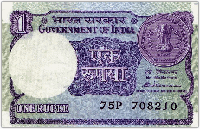 Obverse side of the 1 Indian rupee is showing One Rupee coin with four Lions Capital of Asoka Pillar on it. Ashoka Pillar was sculpted from sandstone, preserved at Sarnath Museum, was originally erected around 250 BCE at Sarnath. |
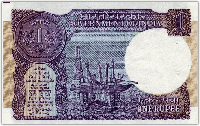 Reverse side of the 1 Indian rupee is showing One Rupee coin, Offshore oil drilling platform (oil rig) Sagar Samrat designed by Offshore Company Mercury Class and built by Mitsubishi at Hiroshima shipyard and delivered in 1973. |
| 2 Indian rupees | |
|---|---|
| Banknote of 2 Indian rupees has dimensions 107×63 mm and main colors are cordovan, grullo, otter brown and pastel gray. | |
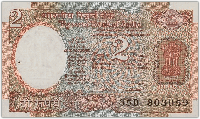 Obverse side of the 2 Indian rupees is showing National Emblem of India - Lion Capital of Asoka (Ashoka column), sculpted from sandstone, preserved at Sarnath Museum which was originally erected around 250 BCE atop an Ashoka Pillar at Sarnath, the wheel "Ashoka Chakra" on it's base is a centerpiece of National Flag of India and the "Satyameva Jayate" National Motto of India is inscribed under it. |
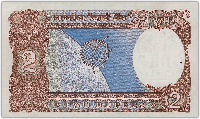 Reverse side of the 2 Indian rupees is showing the Bengal tiger |
| 5 Indian rupees | |
|---|---|
| Banknote of 5 Indian rupees has dimensions 117×63 mm and main colors are asparagus, umber, pale silver and ash grey. | |
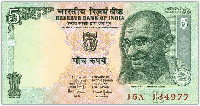 Obverse side of the 5 Indian rupees is showing the portrait of Mohendas Karamchand "Mahatma" Gandhi (2 October 1869 – 30 January 1948). |
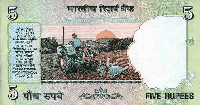 Reverse side of the 5 Indian rupees is showing the farmer ploughing with a tractor while sun is rising. |
| 10 Indian rupees | |
|---|---|
| Banknote of 10 Indian rupees has dimensions 137×63 mm and main colors are peach puff, cinereous, tumbleweed and pale taupe. | |
 Obverse side of the 10 Indian rupees is showing the portrait of Mohendas Karamchand "Mahatma" Gandhi (2 October 1869 – 30 January 1948). |
 Reverse side of the 10 Indian rupees is showing the rhinoceros, elephant and tiger. |
| 20 Indian rupees | |
|---|---|
| Banknote of 20 Indian rupees has dimensions 148×63 mm and main colors are apricot, vivid tangerine, deep chestnut and cosmic latte. | |
 Obverse side of the 20 Indian rupees is showing the portrait of Mohendas Karamchand "Mahatma" Gandhi (2 October 1869 – 30 January 1948). |
 Reverse side of the 20 Indian rupees is showing the seashore view with coconut palm trees. |
| 50 Indian rupees | |
|---|---|
| Banknote of 50 Indian rupees has dimensions 147×73 mm and main colors are thistle, vanilla, pastel purple, cinereous and desert sand. | |
 Obverse side of the 50 Indian rupees is showing the portrait of Mohendas Karamchand "Mahatma" Gandhi (2 October 1869 – 30 January 1948). |
 Reverse side of the 50 Indian rupees is showing the Parliament House of India. |
| 100 Indian rupees | |
|---|---|
| Banknote of 100 Indian rupees has dimensions 157×73 mm and main colors are medium jungle green, ash grey, cambridge blue and pearl. | |
 Obverse side of the 100 Indian rupees is showing the portrait of Mohendas Karamchand "Mahatma" Gandhi (2 October 1869 – 30 January 1948). |
 Reverse side of the 100 Indian rupees is showing the Himalaya mountains and clouds. |
| 500 Indian rupees | |
|---|---|
| Banknote of 500 Indian rupees has dimensions 167×73 mm and main colors are pale spring bud, tan, umber and blond. | |
 Obverse side of the 500 Indian rupees is showing the portrait of Mohendas Karamchand "Mahatma" Gandhi (2 October 1869 – 30 January 1948) and the National Emblem of India - Lion Capital of Asoka (Ashoka column), sculpted from sandstone, preserved at Sarnath Museum which was originally erected around 250 BCE atop an Ashoka Pillar at Sarnath. The wheel "Ashoka Chakra" on it's base is a centerpiece of National Flag of India and "Satyameva Jayate" National Motto of India* is inscribed under it. |
 Reverse side of the 500 Indian rupees is showing the portrait of Mahatma Gandhi and his followers. |
| 1000 Indian rupees | |
|---|---|
| Banknote of 1000 Indian rupees has dimensions 177×73 mm and main colors are desert sand, grullo, papaya whip and misty rose. | |
 Obverse side of the 1000 Indian rupees is showing the portrait of Mohendas Karamchand "Mahatma" Gandhi (2 October 1869 – 30 January 1948) and the National Emblem of India - Lion Capital of Asoka (Ashoka column), sculpted from sandstone, preserved at Sarnath Museum which was originally erected around 250 BCE atop an Ashoka Pillar at Sarnath. The wheel "Ashoka Chakra" on it's base is a centerpiece of National Flag of India and "Satyameva Jayate" National Motto of India* is inscribed under it. |
 Reverse side of the 1000 Indian rupees is showing the economy of India: grain harvesting combine, oil rig, space satellite dish, metallurgy and girl working on a computer. |
Useful links
- About Reserve Bank of India:
- Reserve Bank of India
- List of currencies:
- Currencies
- Security and design features of INR banknotes:
- INR banknotes
- INR currency on Wikipedia:
- Indian rupee
- Official Website of Reserve Bank of India:
- www.rbi.org.in
- Commemorative coins:
- Commemorative Coins